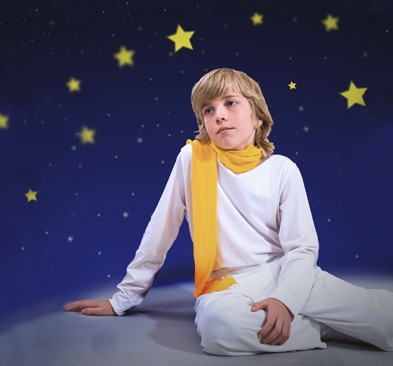“It is only with the heart that one can see rightly; what is essential is invisible to the eye.†These words, penned (in French) during the Second World War by aviator Antoine de Saint-Exupéry, will immediately ring a bell with children of all ages and nationalities.

Ian Pedersen as The Little Prince (Photo: Valentin Radev, graphic design: Lukasz Pinkowski)
Like his book that made those words famous, Ambassador Theater’s The Little Princespeaks to and with the heart of a child in a way that is also accessible to adults. While the small, modest staging space of Flashpoint can sometimes be a drawback for productions that require elaborate costumes or changes in time and place, here the enforced simplicity becomes a virtue, its ostensible disadvantages transformed into opportunities for audiences to see the tale brought to life as a child of Saint-Exupéry’s time would have imagined it.
As the Pilot, the multi-talented Alex Vernon is forthright and earnest, an homme de bonne foi whose very grown-up occupation — and, as the play opens, preoccupation — make him seem an unlikely candidate for friendship with a melancholy interplanetary child. He seems, in fact, a man who would be hard pressed to remember even being a little boy. By turns amused, bemused, impatient, irritated and chagrined, he clearly wants to do the right thing by his mysterious little friend while remaining attentive to “serious thingsâ€: that is, his responsibility to his duty — and his downed aircraft. (Vernon is also the Businessman, the King, the Geographer, and a base for the Lamplighter, played movingly by Sarah Olmstead Thomas with a steadfast, uncompromising devotion to a task that he knows is both futile and irrevocable.)
In an economical but effective turn that acknowledges the limitations of time and space, the entire stage is draped in swaths of white cloth: the desert, on which the pilot’s plane has crash-landed, illuminated intermittently by shafts or sparks of light, or by large, cut-out stars (Gus Soudah). In an imaginatively layered exploitation of the theater’s physical, as the play opens, the theatre’s fourth wall falls away: Sketching on a pad, the Pilot addresses us directly, as Saint-Ex did his young readers, his drawings appearing on the white cloth backdrop behind him as he works. Sometimes they become animated, although always in black in white and in 1930s and 1940s style, again true to time and place.
The Little Prince (Ian Pedersen) makes a star entrance (pun intended) from behind the audience, limned by a halo of light that emphasizes the elegant, princely raiment of white, gold and royal blue familiar to readers of the book. As Tim Treanor observed in this space more than two years ago in his review of Shakespeare Theatre Company’s The Imaginary Invalid: “Do you need an adorable child who can deliver a line with punch and conviction? Why, just trot out Ian Pedersen, and watch him knock them dead.†Here you can watch the still adorable Ian do it not just with a line but with hundreds of them, coolly incarnating the character with skill and self-possession as he smoothly pivots from scolding the uncomprehending Pilot or megalomaniac monarch to musing with a wistful, suddenly adult sadness over his failure to understand his Rose.
The Rose (Ilana Naidamast), seen in flashbacks, is Valley Girl vain and childish, which makes her instantly recognizable as a human and contemporizes the character. (In another interesting bit of staging, the Pilot’s drawing of the Rose assumes human shape when she and the Little Prince speak to each other, their faces appearing silhouetted in miniature on the backdrop.) Naidamast also excels as the Conceited Man, and most memorably as the Snake, hissy and sensuous as she sinuously stretches out her body to the sound of a silky thread of sssssssses, her every arch of an eyebrow and alluring half-smile malevolent and deadly.
Sarah Olmstead Thomas incarnates a stereotype of another sort as a very foxy Fox, a beautiful redhead who plays hard to get as she patiently instructs the Prince on how to tame her, the ritual becoming a dance as her three-foot orange tail swishes and wraps around her. She also has a hilarious bit re-enacting for the puzzled Prince the food chain as she knows it, pantomiming all three parts: the startled but luckless — and pluckless — chicken; the wary but terrified fox; and the beady-eyed, single-minded hunter.
Vernon’s King is especially giggle-inducing as he blissfully insists that he rules “over everything,†grinning like a doofus as he sways his bulbous legs and feet, bopping to the beat of piped-in music. (So agile and almost rag-doll-like is Vernon in the role that I at first thought he was one of the puppets, created by Master Puppeteer and Designer Julia Tasheva and the play’s Director and Designer Lilia Slavova.)
The music is eclectic and nicely done throughout, much of it original (Georg Silver), illuminating the situation or the characters with creatively calibrated shifts from Renaissance to Beethoven, from jazz to pop to bossa nova. The masks (Vanya Vasileva) are richly hued, textured and stylized, seemingly (and successfully) combining Commedia dell’Arte with Bavarian Fasching.
All in all, a show you and your enfant will enjoy seeing together. If you don’t have one or can’t find any, take a grande personne. Although they may not remember it — or want to admit it — I have it on good faith: they were enfants once, too.

Sorry, the comment form is closed at this time.